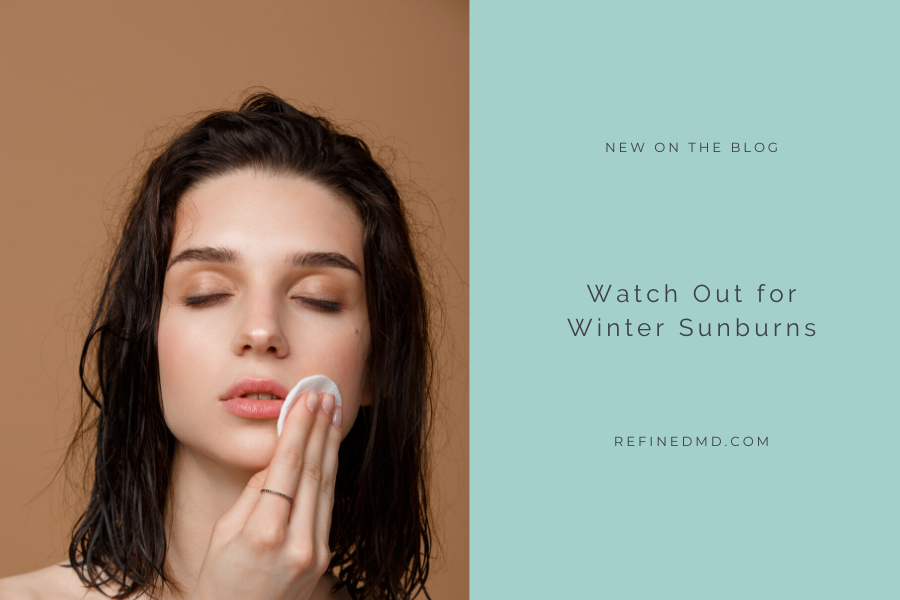
31 Dec Watch Out for Winter Sunburns
Most people don’t use sunscreen as recommended, and at RefinedMD we’ve seen our share of winter sunburns. It doesn’t always happen from a weekend of skiing in the mountains, either. As we wrap up in cozy sweaters and sip on our pumpkin-spiced everything, it’s time for a refresher course in how sunburns work. Re-commit to protecting your skin and enjoying younger looking, more beautiful skin throughout the winter months.
Even if you can’t see the sun, those UV rays are breaking through the clouds. It’s more common to get a traditional sunburn on a cloud-free summer day, but even on the dreariest of days, your skin is at risk. Skin is the largest organ we have, and we expose it to harmful UV rays on a daily basis.
UV Damage Knows No Seasons
Winter sunburns don’t always have the same symptoms as summer burns—although they can. Sometimes, the sun damage is invisible to the naked eye. It can take years for this damage to appear, and prevention always trumps the cure (but we have both!). Think the weather is too frightful for a sunburn or sun damage? Here are a few common winter activities where you might be asking for trouble:
- Daily commutes. You’ve got the heater blasting or the train is nice and toasty. Gloves and jackets are off, and your skin is readily exposed to the sun creeping through those morning and afternoon clouds. This is akin to cruising around in the summer without any sunscreen on.
- Snowman building, ice skating, snow tubing adventures with no protection—all common on those winter holiday getaways. Even if you don’t consider yourself a winter sports lover, you’re probably in the great outdoors more than you think. Marathon runners don’t always stick to the treadmill in the winter, and the temptation to build a snow angel or engage in a snowball fight is irresistible. However, if you aren’t wearing sunscreen during these activities, you’re unprotected.
- If it’s light outside, the sun is shining. It might look like dusk throughout the day, but if it’s light outside the sun can damage your skin. Little things like walking to the mailbox and sitting in the bay window to read are exposing your skin to potential burns and damage.
Sunscreen isn’t just for the summer. Apply it any time you’re exposed to the sun, indoors or outdoors. Reapply every two hours and double check the expiration date.
Where Did This Sunburn Come From?
Many people link sunburns to long periods of direct sunlight exposure, heat, and a lack of sunscreen. This is a common scenario and can lead to more serious burns, but “sunburns” don’t always present as a burn. There may or may not be peeling, redness, or a tan. Sun damage is cumulative over one’s life. Dangerous UV rays can penetrate clouds, which makes it critical to wear sunscreen and/or cover unprotected skin anytime you’re exposed to natural light.
Winter sports enthusiasts know how surprising and painful a “winter burn” is. Even in frigid temperatures, it’s possible to suffer a sunburn. A day spent skiing or snowboarding in the mountains without sunscreen on the face can lead to a painful and potentially dangerous sunburn. However, there are other common circumstances where surprise burns can occur.
Yes, You’re at Risk
Notoriously, long-haul truck drivers have one arm that’s darker and ages faster than the other. Their “window arm” is regularly exposed to sunlight while their other arm is protected by the coverage of the cabin. The same is true of trucker’s faces. CBS News featured the face of a trucker who spent decades driving without sunscreen, and the difference between the two sides of his face is extreme.
Like truck drivers, many people spend a lot of time indoors or commuting and don’t consider how easily sunlight penetrates windows. A person may work in an office all day, but if they are seated next to a window, they are being exposed to hours of UV rays. It is critical to wear sunscreen even while indoors if regular exposure to natural light is the norm. Skylights and large windows can fill homes and offices with natural light.
Protect Your Skin
Not all clothes fully protect the skin from UV rays, either. Clothes with loose weaves or eyelets can allow UV rays to reach the skin. Sun umbrellas are a great option for those who are regularly outside. Traditionally known as parasols, they are still very popular in some Southeast Asian countries.
Re-commit to remembering to wear sunscreen anytime the skin may be exposed to UV rays and to reapply every two hours. And if you do have sun damage, lasers and microneedling are just two of the procedures we offer to undo that damage. Get in touch with RefinedMD today by completing the online form or calling the office.
